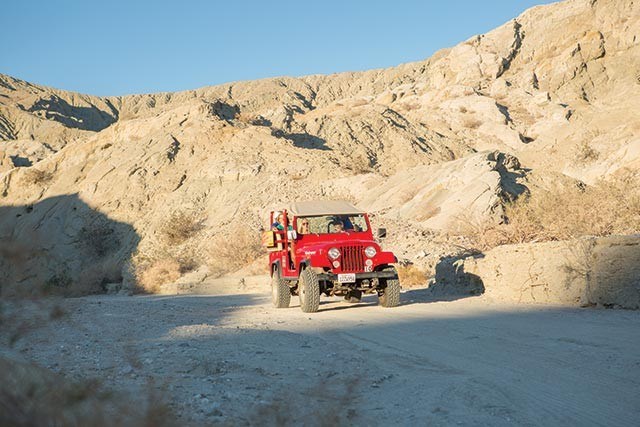Once you step into Morgan Levine's red jeep, you'd better be ready to learn. Short, tan and wiry, somewhere over 55 with a long brown braid and non-stop patter, Levine seems to know everything about Coachella Valley's geology, flora, fauna, Indian tribe and agriculture. And once you sign the Desert Adventures waiver, she'll address you by name for the whole tour.
Levine drives "Ghostwalker," — what the local Cahuilla Indians call mountain lions — one of Desert Adventures' 15 seven-passenger Jeep Scramblers. On a sunny February afternoon, Levine drove my group of seven away from our manicured Palm Desert resort and toward the Indio Hills, deep in the desert. We had signed up for the San Andreas Fault tour, to see what happens where the Pacific and North American plates bump up against each other.
If you draw a circle around the globe, this Southern California desert lines up with Algeria, Syria, Kuwait and Israel. "All the hot deserts of the world are on these latitudes," Levine tells us. So while many visitors come to the greater Palm Springs area for golf and tennis, we were preparing for something a bit more natural.
Out in the fault zone, we're in a valley surrounded by mountains, 15 of which surpass 3,000 metres. Levine points out the way the Pacific plate pushes huge rock faces on their sides as it moves northwestward. "It's the bones of the Earth sticking out here," she says. She shows us how the long history of flooding has left its marks on the surrounding rocks, which are studded with white shell fossils. Camels, zebras, giant sloths and dire wolves once prowled here. Mountain lions still do. "It's like a picture book," Levine says. "You don't have to know how to read. Every line in the wall is a flood." Looking 100-per-cent desert rat in jeans, bandana and a grey hoodie, delighted and satisfied by geology, you'd never guess Levine is from Marin County and used to be an art appraiser.
Desert Adventures has an exclusive lease allowing them access to the 840-acre Metate Ranch, which has been in the Wilhelm family since the mid-1800s. The current Wilhelms prefer their land undeveloped, but allowing jeep tours covers property tax. It's a great arrangement as it gives visitors access to the fault zone with nobody around except their fellow tour-mates.
A fault zone is the area between two tectonic plates. Since an enormous aquifer lies beneath the valley, water springs to the surface wherever the plates rub. The newest friction spawned lines of tiny palms, while older rubs created bigger trees.
Twenty-eight palm canyons straddle the San Andreas Fault. Levine stops at one to give us a lesson on palms. They're monocots, like ferns, and lack the woody tissue of normal trees. Instead, their trunks are more like a series of straws sucking up water. Once they pass the 100-year mark, and attain 15 to 25 metres in height, they're too tall to suck water all the way up, so they die. Levine showed us the wicked thorns that evolved to protect the terminal bud from which all the palm's leaves grow. Up until 13,000 years ago, two types of palm-hungry mammoths roamed this valley. Apparently the palms aren't taking any chances about them coming back.
Levine points out fresh coyote scat. Coyotes are the No.1 gardeners who transplant palms. Thanks to coyotes, a palm grove called the 12 Apostles now numbers 15.
Our schooling continues on the way back to Palm Desert. Levine names all the agricultural crops we pass. Melons are bound for Japan, artichokes for the large Middle Eastern population around Detroit. The biggest crops here are table grapes, citrus, peppers and dates.
Levine makes me feel better about the 124 golf courses marring the desert's face. A weather station on each course measures its evapotranspiration. They refresh the course with grey water, replacing only the amount lost. The golf courses look green, but "they're a short notch from death," Levine says approvingly. "We've always treated water as something precious here." The Cahuillas believe in using water seven times before throwing it away, she adds. In our water-deprived modern world, we have a lot to learn from the desert.
If You Go – Ways to See the Desert
Desert Adventures offers various jeep and hiking tours, and team-building events. red-jeep.com/
The Living Desert Zoo and Gardens introduces you to both local and African desert plants and animals www.livingdesert.org/. Guided hikes or hike on your own from trailheads at the San Jacinto National Monument www.blm.gov/pgdata/content/ca/en/prog/nlcs/SantaRosa_SanJacintoMtns_NM.html
Tourist info on Palm Desert www.palm-desert.org/




